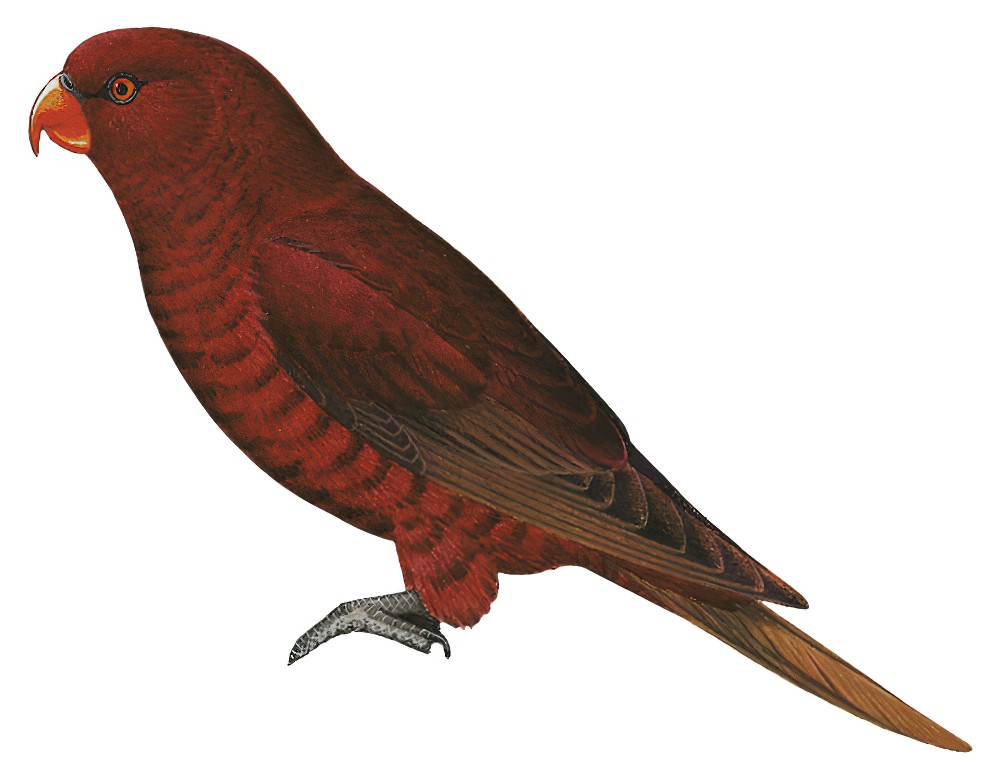Pohnpei Lorikeet / Trichoglossus rubiginosus

Pohnpei Lorikeet
SCI Name:
Protonym: Chalcopsitta rubiginosa Consp.Gen.Av. 1 p.3
Taxonomy: Psittaciformes / Psittaculidae / Trichoglossus
Taxonomy Code: pohlor1
Type Locality: Islands of Barabay and Gebe, error = Ponap6, Caroline Islands.
Author: Bonaparte
Publish Year: 1850
IUCN Status: Near Threatened
DEFINITIONS
TRICHOGLOSSUS
(Psittacidae; Ϯ Coconut Lorikeet T. haematodus) Gr. θριξ thrix, τριχος trikhos hair; γλωσσα glōssa tongue; "GENUS CCXVII.— TRICHOGLOSSUS, Vigors. Rostrum subcrassum, mandibula superior arcuata, inferior subelongata. Lingua apice setosa. Alæ mediocres. Pedes breves; tarsi mediocres. Cauda subbrevis. THE Trichoglossi appear to belong to the old world, New Holland, and the Pacific Islands. Sp. 1. Tr. hæmatopus. Psittacus hæmatopus. Gmel. Syst. Nat. I. p. 357.— Psittacus cyanogaster. Shaw, v. viii. p. 413.— Molucca Islands. Sp. 2. Tr. capistratus. Psittacus capistratus. Beckst.— Psittacus hæmatodes. Shaw, v. viii. p. 415.—Amboyna? Sp. 3. Tr. concinnus. Psittacus concinnus. Shaw, Nat. Misc.—New Holland. Sp. 4. Tr. pusillus. Psittacus pusillus. Shaw, v. viii. p. 471.—New Holland. Sp. 5. Tr? Taitianus. Psittacus Porphyrio. Shaw, v. viii. p. 473. pl. 70.—Otaheite. Sp. 6. Tr? australis. ... Psittacus australis. Nova Act. Acad. Nat. Cur. (Kuhl.) v. x. p. 48. INHABITS New Holland. ... Sp. 7. Tr? chlorolepidotus. ... Psittacus chlorolepidotus. Nova Act. Acad. Cur. (Kuhl.) v. x. p. 48. INHABITS New Holland." (Stephens 1826); “Genus, TRICHOGLOSSUS *. ... Lingua setis plurimis marginalibus ad apicem subtus instructa. ... a decided ground of distinction is exhibited in the formation of the tongue. The under part of this member is furnished at the apex with numerous strong hairs or bristles, of a brush-like structure; and which seem to serve the bird for the purpose of suction. ... *Θριξ seta, and γλωσσα lingua” (Vigors & Horsfield 1827); "Trichoglossus Stephens, in Shaw's Gen. Zool. vol. xiv. p. 129, 1826 (late), ex Vigors & Horsfield, Zool. Journ. vol. ii. p. 281, July 1825, nude name. Type (by subsequent designation, Lesson, Man. d'Orn. vol. ii. p. 147, 1828: T. hæmatodus = T. hæmatopus Steph. = Psittacus moluccanus Gmelin." (Mathews 1927, 292); "Trichoglossus Vigors and Horsfield, Trans. Linn. Soc. London, 15, pt. 1, 1827 (1826), p. 287. Type, by subsequent designation, Psittacus haematodus Linné = Psittacus haematod Linné (G. R. Gray, List Gen. Bds., 1840, p. 51)." (Peters 1937, III, 147); "TRICHOGLOSSUS Stephens, 1826 M — Psittacus haematodus Linnaeus, 1771; type by subsequent designation (Lesson, 1828, Manuel d'Ornithologie, 2, p. 147)." (Dickinson & Remsen (eds.) 2013, 382).
Var. Tricoglossus, Trichoglossa.
Synon. Australasia, Eutelipsitta, Oenopsittacus.
rubiginosa / rubiginosus
L. rubiginosus rusty, ferruginous < rubigo, rubiginis rust < rubeus reddish.
● ex “Ardea naevia” of Miller 1776, and “Rusty-crowned Heron” of Pennant 1785, and Latham 1785 (syn. Nycticorax nycticorax).
UPPERCASE: current genus
Uppercase first letter: generic synonym
● and ● See: generic homonyms
lowercase: species and subspecies
●: early names, variants, mispellings
‡: extinct
†: type species
Gr.: ancient Greek
L.: Latin
<: derived from
syn: synonym of
/: separates historical and modern geographic names
ex: based on
TL: type locality
OD: original diagnosis (genus) or original description (species)












